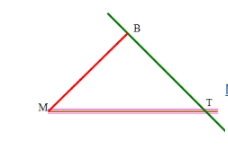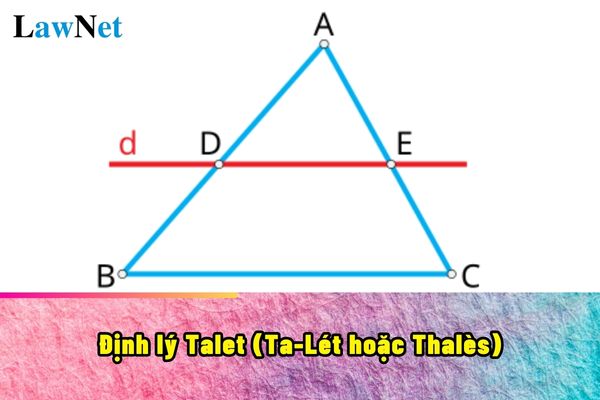What is Thales' theorem? What is the formula of Thales' theorem? According to the regulations, when do students in Vietnam learn Thales' theorem?
What is Thales' theorem? What is the formula of Thales' theorem?
Thales' theorem is one of the basic and most important theorems in geometry. This theorem is named after Thales, the Greek mathematician, who was the first to discover the special relationship between line segments when a parallel line intersects two sides of a triangle.
The Thales' theorem states:
If a line is parallel to one side of a triangle and intersects the other two sides, it creates segments on these two sides that are proportional.
Conversely, the Thales' theorem states:
If a line intersects two sides of a triangle and creates proportional segments on these two sides, then that line is parallel to the remaining side of the triangle.
Furthermore, the Thales' theorem does not have a specific formula like the formulas for area or circumference. Instead, this theorem expresses a proportional relationship between the segments formed when a parallel line intersects two sides of a triangle.
Example:
Given triangle ABC. Line DE is parallel to BC and intersects AB at D and AC at E. Given AD = 4cm, DB = 6cm, AE = 3cm. Calculate the length of segment EC.
Solution:
Draw the diagram: Please draw triangle ABC with line DE parallel to BC, mark points D, E, and the given lengths.
Apply the Thales' theorem: Since DE // BC, we have: AD/DB = AE/EC
Substitute the values into the equation: 4/6 = 3/EC
Solve the equation: To find EC, we cross-multiply: 4 * EC = 6 * 3 4 * EC = 18 EC = 18 / 4 EC = 4.5 cm
Thus, the length of segment EC is 4.5 cm.
Illustration:

Explanation of the steps:
Draw the diagram: Drawing the diagram helps us better visualize the problem and the relationships between the segments.
Apply the theorem: We notice that DE // BC, which is the condition to apply the Thales' theorem.
Establish the proportion: From the Thales' theorem, we can establish a proportion between the corresponding segments.
Solve the equation: From the proportion, we establish an equation and solve for the unknown value.
*Note: This information is for reference only./.
When do students in Vietnam learn Thales' theorem?
Based on Section V of the Annex of the General Education Program for the subject of Mathematics issued together with Circular 32/2018/TT-BGDDT, the curriculum for grade 8 mathematics is as follows:
The Thales' theorem in a triangle includes the following content:
- Explain the Thales' theorem in a triangle (direct and converse theorems).
- Describe the definition of the midline of a triangle. Explain the properties of the midline of a triangle (the midline of a triangle is parallel to the third side and equals half of that side).
- Explain the properties of the interior angle bisector of a triangle.
- Calculate the length of a segment using the Thales' theorem.
- Solve some practical problems applying the Thales' theorem (e.g., calculating the distance between two positions).
Therefore, the Thales' theorem is taught to students in grade 8.

What is Thales' theorem? What is the formula of Thales' theorem? According to the regulations, when do students in Vietnam learn Thales' theorem? (Image from the Internet)
What are principles for developing Mathematics curriculum in Vietnam?
Based on Section II of the Annex of the General Education Program for the subject of Mathematics issued together with Circular 32/2018/TT-BGDDT, principles for developing Mathematics curriculum in Vietnam include:
The mathematics curriculum adheres to the basic regulations stated in the overall program; inherits and promotes the advantages of the current and previous programs, selectively adopts the experience of curriculum development from advanced countries worldwide, accesses the achievements of educational science, and considers the economic and social conditions of Vietnam.
Additionally, the mathematics curriculum emphasizes some viewpoints as follows:
Viewpoint 1. Ensure simplicity, practicality, and modernity
The mathematics curriculum ensures simplicity, practicality, and modernity by reflecting essential content that must be addressed in general education, meeting the need to understand the world and the interests of learners, and conforming to contemporary world approaches.
The program embraces the spirit of “mathematics for everyone,” everyone can learn Mathematics but each person can learn Mathematics in a way that suits their interests and abilities.
The mathematics curriculum focuses on application, connectedness with practical life or other subjects, especially subjects aimed at implementing STEM education, aligned with modern developmental trends in economics, science, social life, and urgent global issues (such as climate change, sustainable development, financial education, and so on).
This is also reflected through practical and experiential activities in mathematics education with various forms such as: conducting study projects on Mathematics, especially those about the application of mathematics in practical life;
Organizing mathematical learning games, math clubs, forums, seminars, competitions about Mathematics, etc., creating opportunities for students to creatively apply their knowledge, skills, and experiences to practical situations.
Viewpoint 2. Ensure consistency, coherence, and continuous development
The mathematics curriculum ensures consistency, coherence, and continuous development from grade 1 to grade 12, including two closely linked branches, one describing the development of core content knowledge strands and the other describing the development of students' competencies and qualities.
At the same time, the mathematics curriculum considers continuity with the preschool education program and forms the foundation for vocational education and higher education.
Viewpoint 3. Ensure integrative and differentiated approaches
The mathematics curriculum carries out internal integration around three knowledge strands: Numbers, Algebra and some elements of Calculus; Geometry and Measurement; Statistics and Probability; and interdisciplinary integration through related content or mathematical knowledge used in other subjects such as Physics, Chemistry, Biology, Geography, Informatics, Technology, History, Arts, etc.
It ensures internal and interdisciplinary integration through practical and experiential activities in mathematics education.
Simultaneously, the mathematics curriculum ensures differentiated requirements. For all levels of education, the mathematics curriculum embodies the spirit of personalized learning based on ensuring that most students (across all regions nationwide) meet the program's necessary requirements; while paying attention to special groups (gifted students, students with disabilities, students in difficult circumstances, etc.).
For the high school level, the mathematics curriculum includes a system of in-depth study topics and learning content to help students enhance their knowledge, practical skills, and application to solve problems related to practical life.
Viewpoint 4. Ensure openness
The mathematics curriculum ensures unified orientation and core, mandatory mathematics education content for students nationwide, while giving localities and schools autonomy and responsibility in selecting and supplementing some mathematics education content and implementing educational plans suited to the local education context and conditions.
The mathematics curriculum only stipulates general principles and orientations regarding the required achievements in students' competencies and qualities, educational content, educational methods, and evaluation of educational results. It does not specify in too much detail, thereby enabling textbook authors and teachers to exercise initiative and creativity in implementing the curriculum.
The curriculum ensures stability and the potential for development during implementation to suit scientific-technological progress and actual needs.
>>> See more Preparing for the overview of the cell in Biology 10 according to Canh Dieu curriculum in Vietnam
>>> See more Preparing lessons included in the textbook Mathematics 10 according to Volume 1 Canh Dieu curriculum in Vietnam
>>> See more Guideline for preparing the lesson Thanh âm của gió for grade 5 students in Vietnam
>>> See more Guideline for preparing the lesson nouns, verbs, and adjectives for grade 5 students in Vietnam
>>> See more Guideline for learning the lesson of word practice and sentences (Pronouns) for grade 5 students in Vietnam
>>> See more Short essay describing the teacher for grade 5 students in Vietnam for the school year 2024-2025
>>> >>> Download the General Education Program for Mathematics issued together with Circular 32/2018/TT-BGDDT.

